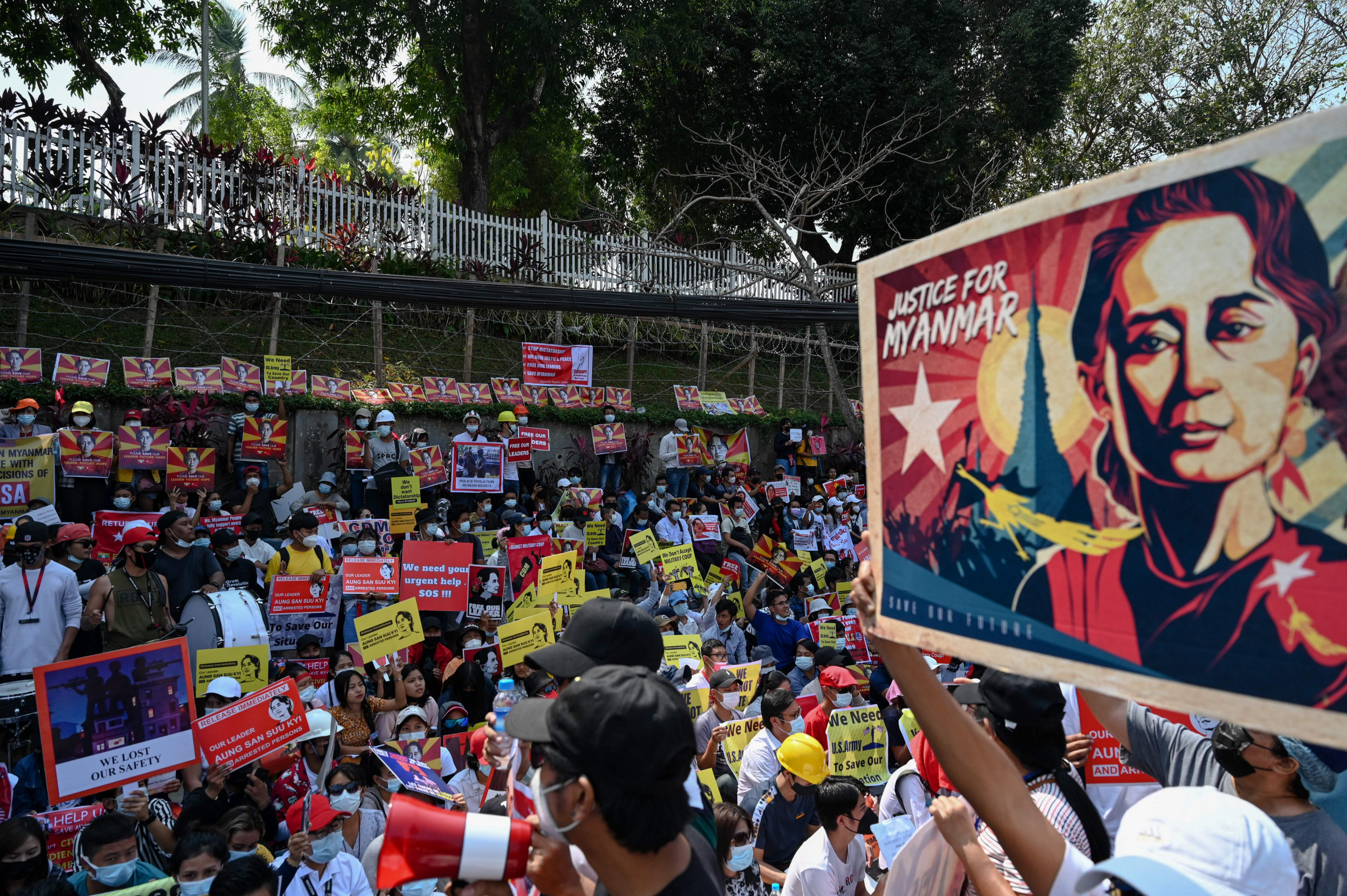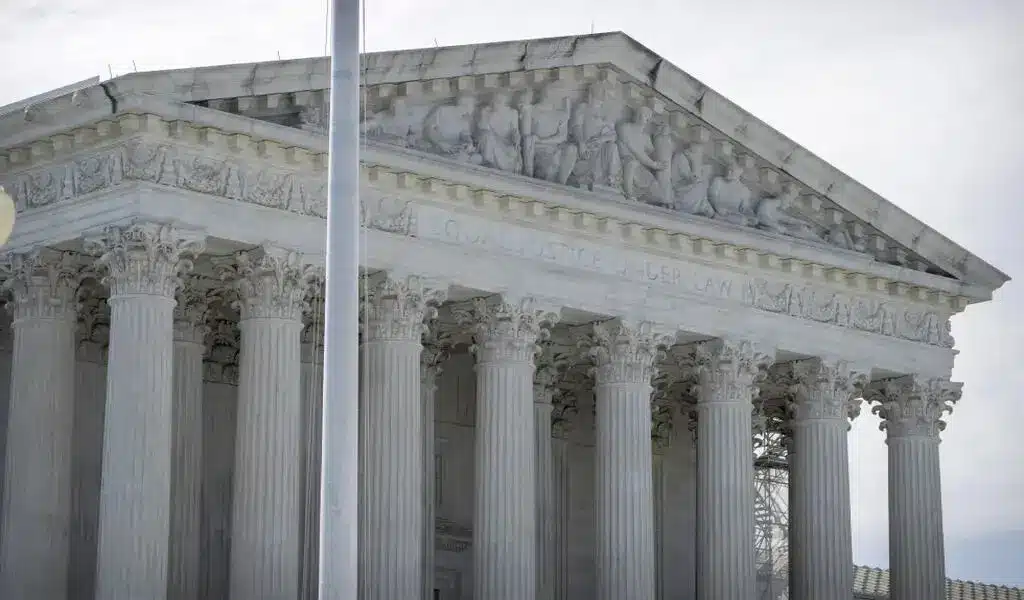News
Thailand’s Foreign Minister Has Clandestine Meeting With Myanmar’s Aung San Suu Kyi
Thailand’s outgoing foreign minister travelled to Myanmar in secret, meeting with imprisoned elected leader Aung San Suu Kyi only days before a regional summit focused on the country’s crisis.
Don Pramudwinai acknowledged the visit to reporters on the sidelines of the Association of Southeast Asian Nations (ASEAN) foreign ministers meeting in Jakarta on Wednesday, but declined to elaborate.
He described it as “an approach of Myanmar’s friends who want to see a peaceful settlement.”
According to Aljazeera, Don flew into Naypyidaw on a special military plane and returned home the same day after meeting with Myanmar’s military council, which included Min Aung Hlaing. It made no mention of him seeing Aung San Suu Kyi, who was detained by the generals as they seized power in February 2021 and has since been imprisoned following a series of sham trials.
Thailand’s outgoing army-backed government has sparked controversy in recent months, despite their failure to make headway on a unanimously agreed ASEAN five-point plan to address the turmoil prompted by the coup.
Don is reported to have visited Naypyidaw in April and to have planned a meeting last month to “re-engage” with the generals who have been barred from attending the group’s top summits owing to their inability to follow the peace plan.
Thailand’s foreign ministry acknowledged in a statement that the travel took place on Sunday and that Don spent “over an hour” with Aung San Suu Kyi, who is now 78.

Don assured the ministers in Jakarta that she was in good physical and mental condition. “She encouraged conversation,” Don stated. Despite being part of the five-point plan, the military has rebuffed all diplomatic requests to meet with Aung San Suu Kyi during the last two years.
Don’s travel, according to Aaron Connelly, a Southeast Asia researcher at the International Institute for Strategic Studies in Singapore, weakened ASEAN’s efforts to resolve the problem. Myanmar joined ASEAN 25 years ago under a previous military dictatorship.
“A diplomatic process centred on Myanmar’s neighbours, rather than ASEAN, will be more sympathetic to the junta,” tweeted Connelly. “Its neighbours believe the junta will eventually triumph and want to hasten its pacification of the countryside and international legitimization.”
Retno Marsudi, Indonesia’s Foreign Minister, emphasised the need of ASEAN unity, telling her peers on Wednesday that “only a political solution [would] lead to a durable peace.” On Wednesday afternoon, the group was hammering out a consensus position on Myanmar.
The US, whose senior diplomat Antony Blinken will also attend the Jakarta meetings, has already stated that it intends to use the gathering to persuade ASEAN to retain its firm position.
The top State Department official for East Asia, Daniel Kritenbrink, told reporters last week that Myanmar would be “one of the key issues” covered in Jakarta.
Without attacking Thailand, Kritenbrink stated that the US expected the bloc to “continue to downgrade Myanmar’s representation in the ASEAN ministerial”.
“We also look forward to finding ways to increase pressure on the regime in order to compel it to end its violence and return to a path of democracy,” he said. Don’s travel was not covered in Myanmar’s official media.

Myanmar’s Aung San Suu Kyi
Aung San Suu Kyi is a prominent figure in Myanmar (formerly known as Burma) and a Nobel Peace Prize laureate. She was born on June 19, 1945, in Yangon, Myanmar. Aung San Suu Kyi’s father, Aung San, was a national hero who played a crucial role in the country’s struggle for independence from British colonial rule.
Aung San Suu Kyi spent much of her early life abroad due to her father’s diplomatic work, but she later returned to Myanmar in 1988 to take care of her ailing mother. At that time, Myanmar was under military rule, and the country was experiencing widespread civil unrest and pro-democracy movements.
Inspired by the growing democratic movement, Aung San Suu Kyi emerged as a leader and advocate for democracy in Myanmar. She co-founded the National League for Democracy (NLD) in 1988 and became its leader. The NLD aimed to bring about political reforms and establish a democratic government in Myanmar.
Aung San Suu Kyi’s nonviolent resistance to the military junta led to her house arrest in 1989. She remained under house arrest for a total of 15 years over the next two decades. Despite her confinement, she continued to be a symbol of hope and resistance for the people of Myanmar.
In 1991, Aung San Suu Kyi was awarded the Nobel Peace Prize for her peaceful and nonviolent struggle for democracy and human rights. Her commitment to democratic principles and her perseverance in the face of adversity gained her international recognition and support.

In 2010, the military junta in Myanmar began to loosen its grip on power and initiated a series of political reforms. Aung San Suu Kyi was released from house arrest in 2010, and her party, the NLD, participated in the country’s parliamentary elections in 2012. The NLD won a majority of the seats, and Aung San Suu Kyi became the de facto leader of Myanmar.
However, her leadership was not without controversy. During her time in power, Aung San Suu Kyi faced criticism for her handling of the Rohingya crisis, a violent conflict that led to the displacement and persecution of the Rohingya Muslim minority in Myanmar. Many accused her government of human rights abuses and failing to protect the Rohingya population.
In 2017, a military crackdown on the Rohingya people resulted in widespread violence and forced displacement, leading to international condemnation. Aung San Suu Kyi’s response to the crisis drew criticism from human rights organizations and the international community, tarnishing her reputation as a champion of human rights and democracy.
In light of the Rohingya crisis, Aung San Suu Kyi faced legal consequences. In 2019, she defended Myanmar at the International Court of Justice against accusations of genocide. However, in January 2020, the International Court of Justice ordered Myanmar to take immediate measures to prevent genocide against the Rohingya and preserve evidence of past atrocities.
In February 2021, the military in Myanmar staged a coup, ousting the civilian government and detaining Aung San Suu Kyi and other political leaders. Since then, Myanmar has experienced widespread protests and violence as the military junta suppresses dissent and maintains control over the country.
Aung San Suu Kyi’s political journey has been complex and polarizing, with her image shifting from an icon of democracy and human rights to a figure criticized for her inaction and silence in the face of human rights abuses. Her legacy continues to be a subject of debate and reflection in Myanmar and the international community.

News
Trudeau’s Gun Grab Could Cost Taxpayers a Whopping $7 Billion

A recent report indicates that since Trudeau’s announcement of his gun buyback program four years ago, almost none of the banned firearms have been surrendered.
The federal government plans to purchase 2,063 firearm models from retailers following the enactment of Bill C-21, which amends various Acts and introduces certain consequential changes related to firearms. It was granted royal assent on December 15 of last year.
This ban immediately criminalized the actions of federally-licensed firearms owners regarding the purchase, sale, transportation, importation, exportation, or use of hundreds of thousands of rifles and shotguns that were previously legal.
The gun ban focused on what it termed ‘assault-style weapons,’ which are, in reality, traditional semi-automatic rifles and shotguns that have enjoyed popularity among hunters and sport shooters for over a century.
In May 2020, the federal government enacted an Order-in-Council that prohibited 1,500 types of “assault-style” firearms and outlined specific components of the newly banned firearms. Property owners must adhere to the law by October 2023.
Trudeau’s Buyback Hasn’t Happened
“In the announcement regarding the ban, the prime minister stated that the government would seize the prohibited firearms, assuring that their lawful owners would be ‘grandfathered’ or compensated fairly.” “That hasn’t happened,” criminologist Gary Mauser told Rebel News.
Mauser projected expenses ranging from $2.6 billion to $6.7 billion. The figure reflects the compensation costs amounting to $756 million, as outlined by the Parliamentary Budget Office (PBO).
“The projected expenses for gathering the illegal firearms are estimated to range from $1.6 billion to $7 billion.” “This range estimate increases to between $2.647 billion and $7 billion when compensation costs to owners are factored in,” Mauser stated.
Figures requested by Conservative MP Shannon Stubbs concerning firearms prohibited due to the May 1, 2020 Order In Council reveal that $72 million has been allocated to the firearm “buyback” program, yet not a single firearm has been confiscated to date.
In a recent revelation, Public Safety Canada disclosed that the federal government allocated a staggering $41,094,556, as prompted by an order paper question from Conservative Senator Don Plett last September, yet yielded no tangible outcomes.
An internal memo from late 2019 revealed that the Liberals projected their politically motivated harassment would incur a cost of $1.8 billion.
Enforcement efforts Questioned
By December 2023, estimates from TheGunBlog.ca indicate that the Liberals and RCMP had incurred or were responsible for approximately $30 million in personnel expenses related to the enforcement efforts. The union representing the police service previously stated that the effort to confiscate firearms is a “misdirected effort” aimed at ensuring public safety.
“This action diverts crucial personnel, resources, and funding from tackling the more pressing and escalating issue of criminal use of illegal firearms,” stated the National Police Federation (NPF).
The Canadian Sporting Arms & Ammunition Association (CSAAA), representing firearms retailers, has stated it will have “zero involvement” in the confiscation of these firearms. Even Canada Post held back from providing assistance due to safety concerns.
The consultant previously assessed that retailers are sitting on almost $1 billion worth of inventory that cannot be sold or returned to suppliers because of the Order-In-Council.
“Despite the ongoing confusion surrounding the ban, after four years, we ought to be able to address one crucial question.” Has the prohibition enhanced safety for Canadians? Mauser asks.
Illegally Obtained Firearms are the Problem
Statistics Canada reports a 10% increase in firearm-related violent crime between 2020 and 2022, rising from 12,614 incidents to 13,937 incidents. In that timeframe, the incidence of firearm-related violent crime increased from 33.7 incidents per 100,000 population in 2021 to 36.7 incidents the subsequent year.
“This marks the highest rate documented since the collection of comparable data began in 2009,” the criminologist explains.
Supplementary DataData indicates that firearm homicides have risen since 2020. “The issue lies not with lawfully-held firearms,” Mauser stated.
Firearms that have been banned under the Order-in-Council continue to be securely stored in the safes of their lawful owners. The individuals underwent a thorough vetting process by the RCMP and are subject to nightly monitoring to ensure there are no infractions that could pose a risk to public safety.
“The firearms involved in homicides were seldom legally owned weapons wielded by their rightful owners,” Mauser continues. The number of offenses linked to organized crime has surged from 4,810 in 2016 to a staggering 13,056 in 2020.
“If those in power … aim to diminish crime and enhance public safety, they ought to implement strategies that effectively focus on offenders and utilize our limited tax resources judiciously to reach these objectives,” he stated.
Related News:
Millennials in Canada Have Turned their Backs on Justin Trudeau
Millennials in Canada Have Turned their Backs on Justin Trudeau
News
Google’s Search Dominance Is Unwinding, But Still Accounting 48% Search Revenue

Google is so closely associated with its key product that its name is a verb that signifies “search.” However, Google’s dominance in that sector is dwindling.
According to eMarketer, Google will lose control of the US search industry for the first time in decades next year.
Google will remain the dominant search player, accounting for 48% of American search advertising revenue. And, remarkably, Google is still increasing its sales in the field, despite being the dominating player in search since the early days of the George W. Bush administration. However, Amazon is growing at a quicker rate.
Google’s Search Dominance Is Unwinding
Amazon will hold over a quarter of US search ad dollars next year, rising to 27% by 2026, while Google will fall even more, according to eMarketer.
The Wall Street Journal was first to report on the forecast.
Lest you think you’ll have to switch to Bing or Yahoo, this isn’t the end of Google or anything really near.
Google is the fourth-most valued public firm in the world. Its market worth is $2.1 trillion, trailing just Apple, Microsoft, and the AI chip darling Nvidia. It also maintains its dominance in other industries, such as display advertisements, where it dominates alongside Facebook’s parent firm Meta, and video ads on YouTube.
To put those “other” firms in context, each is worth more than Delta Air Lines’ total market value. So, yeah, Google is not going anywhere.
Nonetheless, Google faces numerous dangers to its operations, particularly from antitrust regulators.
On Monday, a federal judge in San Francisco ruled that Google must open up its Google Play Store to competitors, dealing a significant blow to the firm in its long-running battle with Fortnite creator Epic Games. Google announced that it would appeal the verdict.
In August, a federal judge ruled that Google has an illegal monopoly on search. That verdict could lead to the dissolution of the company’s search operation. Another antitrust lawsuit filed last month accuses Google of abusing its dominance in the online advertising business.
Meanwhile, European regulators have compelled Google to follow tough new standards, which have resulted in multiple $1 billion-plus fines.

Pixa Bay
Google’s Search Dominance Is Unwinding
On top of that, the marketplace is becoming more difficult on its own.
TikTok, the fastest-growing social network, is expanding into the search market. And Amazon has accomplished something few other digital titans have done to date: it has established a habit.
When you want to buy anything, you usually go to Amazon, not Google. Amazon then buys adverts to push companies’ products to the top of your search results, increasing sales and earning Amazon a greater portion of the revenue. According to eMarketer, it is expected to generate $27.8 billion in search revenue in the United States next year, trailing only Google’s $62.9 billion total.
And then there’s AI, the technology that (supposedly) will change everything.
Why search in stilted language for “kendall jenner why bad bunny breakup” or “police moving violation driver rights no stop sign” when you can just ask OpenAI’s ChatGPT, “What’s going on with Kendall Jenner and Bad Bunny?” in “I need help fighting a moving violation involving a stop sign that wasn’t visible.” Google is working on exactly this technology with its Gemini product, but its success is far from guaranteed, especially with Apple collaborating with OpenAI and other businesses rapidly joining the market.
A Google spokeswoman referred to a blog post from last week in which the company unveiled ads in its AI overviews (the AI-generated text that appears at the top of search results). It’s Google’s way of expressing its ability to profit on a changing marketplace while retaining its business, even as its consumers steadily transition to ask-and-answer AI and away from search.

Google has long used a single catchphrase to defend itself against opponents who claim it is a monopoly abusing its power: competition is only a click away. Until recently, that seemed comically obtuse. Really? We are going to switch to Bing? Or Duck Duck Go? Give me a break.
But today, it feels more like reality.
Google is in no danger of disappearing. However, every highly dominating company faces some type of reckoning over time. GE, a Dow mainstay for more than a century, was broken up last year and is now a shell of its previous dominance. Sears declared bankruptcy in 2022 and is virtually out of business. US Steel, long the foundation of American manufacturing, is attempting to sell itself to a Japanese corporation.
SOURCE | CNN
News
The Supreme Court Turns Down Biden’s Government Appeal in a Texas Emergency Abortion Matter.

(VOR News) – A ruling that prohibits emergency abortions that contravene the Supreme Court law in the state of Texas, which has one of the most stringent abortion restrictions in the country, has been upheld by the Supreme Court of the United States. The United States Supreme Court upheld this decision.
The justices did not provide any specifics regarding the underlying reasons for their decision to uphold an order from a lower court that declared hospitals cannot be legally obligated to administer abortions if doing so would violate the law in the state of Texas.
Institutions are not required to perform abortions, as stipulated in the decree. The common populace did not investigate any opposing viewpoints. The decision was made just weeks before a presidential election that brought abortion to the forefront of the political agenda.
This decision follows the 2022 Supreme Court ruling that ended abortion nationwide.
In response to a request from the administration of Vice President Joe Biden to overturn the lower court’s decision, the justices expressed their disapproval.
The government contends that hospitals are obligated to perform abortions in compliance with federal legislation when the health or life of an expectant patient is in an exceedingly precarious condition.
This is the case in regions where the procedure is prohibited. The difficulty hospitals in Texas and other states are experiencing in determining whether or not routine care could be in violation of stringent state laws that prohibit abortion has resulted in an increase in the number of complaints concerning pregnant women who are experiencing medical distress being turned away from emergency rooms.
The administration cited the Supreme Court’s ruling in a case that bore a striking resemblance to the one that was presented to it in Idaho at the beginning of the year. The justices took a limited decision in that case to allow the continuation of emergency abortions without interruption while a lawsuit was still being heard.
In contrast, Texas has been a vocal proponent of the injunction’s continued enforcement. Texas has argued that its circumstances are distinct from those of Idaho, as the state does have an exemption for situations that pose a significant hazard to the health of an expectant patient.
According to the state, the discrepancy is the result of this exemption. The state of Idaho had a provision that safeguarded a woman’s life when the issue was first broached; however, it did not include protection for her health.
Certified medical practitioners are not obligated to wait until a woman’s life is in imminent peril before they are legally permitted to perform an abortion, as determined by the state supreme court.
The state of Texas highlighted this to the Supreme Court.
Nevertheless, medical professionals have criticized the Texas statute as being perilously ambiguous, and a medical board has declined to provide a list of all the disorders that are eligible for an exception. Furthermore, the statute has been criticized for its hazardous ambiguity.
For an extended period, termination of pregnancies has been a standard procedure in medical treatment for individuals who have been experiencing significant issues. It is implemented in this manner to prevent catastrophic outcomes, such as sepsis, organ failure, and other severe scenarios.
Nevertheless, medical professionals and hospitals in Texas and other states with strict abortion laws have noted that it is uncertain whether or not these terminations could be in violation of abortion prohibitions that include the possibility of a prison sentence. This is the case in regions where abortion prohibitions are exceedingly restrictive.
Following the Supreme Court’s decision to overturn Roe v. Wade, which resulted in restrictions on the rights of women to have abortions in several Republican-ruled states, the Texas case was revisited in 2022.
As per the orders that were disclosed by the administration of Vice President Joe Biden, hospitals are still required to provide abortions in cases that are classified as dire emergency.
As stipulated in a piece of health care legislation, the majority of hospitals are obligated to provide medical assistance to patients who are experiencing medical distress. This is in accordance with the law.
The state of Texas maintained that hospitals should not be obligated to provide abortions throughout the litigation, as doing so would violate the state’s constitutional prohibition on abortions. In its January judgment, the 5th United States Circuit Court of Appeals concurred with the state and acknowledged that the administration had exceeded its authority.
SOURCE: AP
SEE ALSO:
Could Last-Minute Surprises Derail Kamala Harris’ Campaign? “Nostradamus” Explains the US Poll.
-

 News3 years ago
News3 years agoLet’s Know About Ultra High Net Worth Individual
-
Entertainment2 years ago
Mabelle Prior: The Voice of Hope, Resilience, and Diversity Inspiring Generations
-

 Health3 years ago
Health3 years agoHow Much Ivermectin Should You Take?
-

 Tech2 years ago
Tech2 years agoTop Forex Brokers of 2023: Reviews and Analysis for Successful Trading
-

 Lifestyles3 years ago
Lifestyles3 years agoAries Soulmate Signs
-

 Movies2 years ago
Movies2 years agoWhat Should I Do If Disney Plus Keeps Logging Me Out of TV?
-

 Health3 years ago
Health3 years agoCan I Buy Ivermectin Without A Prescription in the USA?
-

 Learning2 years ago
Learning2 years agoVirtual Numbers: What Are They For?
